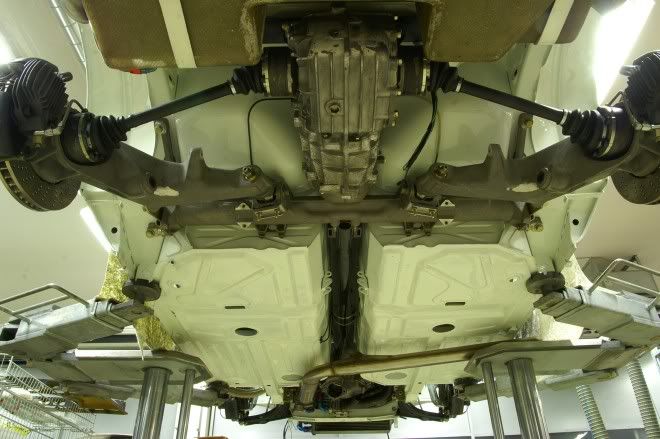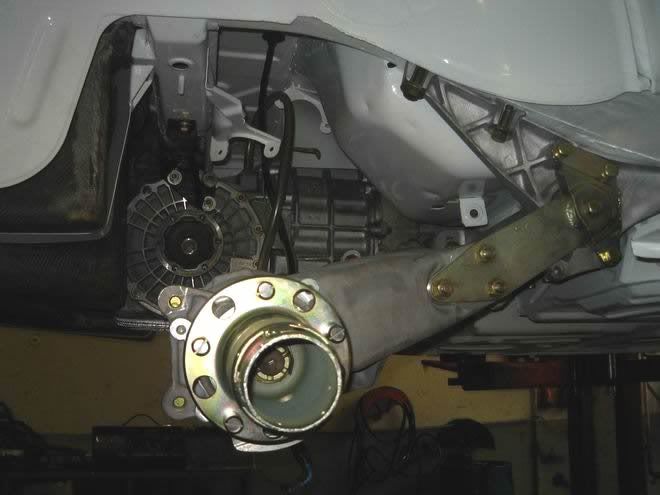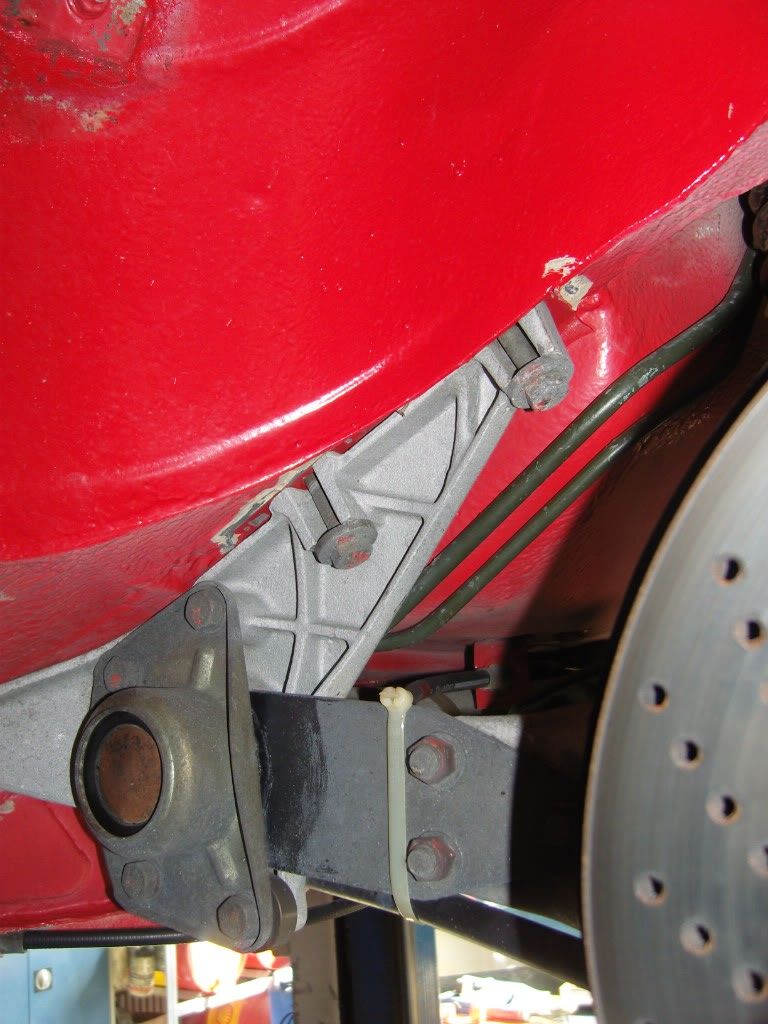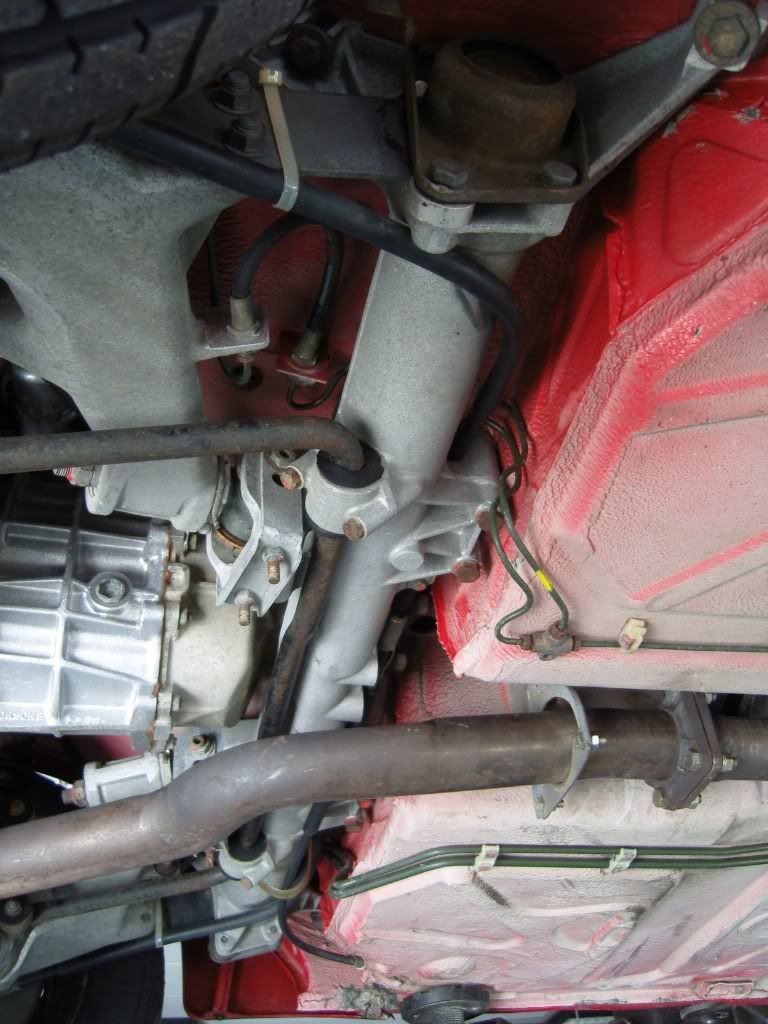You should upgrade or use an alternative browser.
944 Turbo Rear Suspension
- Thread starter barks944
- Start date
Jonny944CS
New member
Anyone looked at rear torsion bar removal using the KWV3's?
Not sure if this helps, but from memory, I used the factory spec for a 968 with M030 (helper springs on the rear)
= 9°angle between the spring plate top surface and the flat section at the top of the reactor blade.
(Factory spec for a 944T with 25.5mm bars = 18°)
1° is approximately equal to 5mm of ride height change, but you have around +/-15mm of ride height adjustment from the eccentric when they are nice and clean.
With the weight on the wheels, and some fine tuning using the eccentrics, the car sat lower than my target ride height by around 20mm. By fitting the KW's it lifted it back to the correct height and closed up the helper springs.
At the time I figured that was the best way to share out the two spring types. Not sure if this is best way to approach it or not"¦
The 924 Haynes manual provides a good quality description of the indexing procedure. I can try to scan and post it if you don't already have it.
sawood12
New member
ORIGINAL: barks944
Damn, one of the bars fell out on dissasembly and I was relying on the fact I measured the other one to get them both back right! I guess if they were different that presents a problem. How come they drop, do the torsion bars get weak?
The rear torsion bars used to slip on the indexing. Not sure why, but I have heard of it quite alot. It must have been a temporary spate which Porsche fixed.
Jonny944CS
New member
Damn, one of the bars fell out on dissasembly and I was relying on the fact I measured the other one to get them both back right! I guess if they were different that presents a problem. How come they drop, do the torsion bars get weak?
The rear torsion bars used to slip on the indexing. Not sure why, but I have heard of it quite alot. It must have been a temporary spate which Porsche fixed.
I guess, to some extent, this is inherently the case with torsion bar suspension in general.
The torsion bars will respond elastically up to their point of maximum stress. But may, if only very slightly, dip into yield occasionally. Each time this happens, the neutral re-set position of the bars will change, very slightly.
The stiffness of a round bar is derived from the 3rd power of its diameter and the material's Young's Modulus. Therefore no reduction in stiffness will occur through yield induced re-setting. The bars will also be designed (constrained by the physical limits of the wheel travel) to not to yield excessively and operate comfortably inside their fatigue limit, during normal operating conditions.
Perhaps the 'sagging' characteristic is quite sensitive to batch manufacturing tolerances and steel cleanliness...
Potential ways of influencing the mechanical properties of the Tbar include heat treatment and pre-setting processes, but VW/Porsche have been designing and manufacturing torsion bars in huge quantities for a good many years, so I'd like to think they were pretty consistent at it. The 968 was one of the last in a long line torsion bar sprung cars stretching back to the early 1900's and I've seen plenty of late model 968's and 944's with saggy rear ends. The heavier models will of course show any slight shift in the neutral position more clearly.
A car could conceivably put more stress on its nearside T bar (compared to offside) due to clouting into more potholes, drain covers etc. My gut feeling is that I would be surprised if the change side-to-side was large enough to be outside the fine-tuning scope of the eccentrics and therefore enough to warrant different side-side indexing.
Barks, if you are worried you could consider new bars. If it were me, I would just put it back together at a sensible spring plate angle and fine-tune using the eccentrics and KW helper-spring seats.
sawood12
New member
ORIGINAL: Jonny944CS
Damn, one of the bars fell out on dissasembly and I was relying on the fact I measured the other one to get them both back right! I guess if they were different that presents a problem. How come they drop, do the torsion bars get weak?
The rear torsion bars used to slip on the indexing. Not sure why, but I have heard of it quite alot. It must have been a temporary spate which Porsche fixed.
I guess, to some extent, this is inherently the case with torsion bar suspension in general.
The torsion bars will respond elastically up to their point of maximum stress. But may, if only very slightly, dip into yield occasionally. Each time this happens, the neutral re-set position of the bars will change, very slightly.
The stiffness of a round bar is derived from the 3rd power of its diameter and the material's Young's Modulus. Therefore no reduction in stiffness will occur through yield induced re-setting. The bars will also be designed (constrained by the physical limits of the wheel travel) to not to yield excessively and operate comfortably inside their fatigue limit, during normal operating conditions.
Perhaps the 'sagging' characteristic is quite sensitive to batch manufacturing tolerances and steel cleanliness...
Potential ways of influencing the mechanical properties of the Tbar include heat treatment and pre-setting processes, but VW/Porsche have been designing and manufacturing torsion bars in huge quantities for a good many years, so I'd like to think they were pretty consistent at it. The 968 was one of the last in a long line torsion bar sprung cars stretching back to the early 1900's and I've seen plenty of late model 968's and 944's with saggy rear ends. The heavier models will of course show any slight shift in the neutral position more clearly.
A car could conceivably put more stress on its nearside T bar (compared to offside) due to clouting into more potholes, drain covers etc. My gut feeling is that I would be surprised if the change side-to-side was large enough to be outside the fine-tuning scope of the eccentrics and therefore enough to warrant different side-side indexing.
Barks, if you are worried you could consider new bars. If it were me, I would just put it back together at a sensible spring plate angle and fine-tune using the eccentrics and KW helper-spring seats.
Maybe, not sure what the mechanism is, but I assumed it was that the actual splines had slipped and maybe Porsche changed the manufacturing tolerances in later cars to eliminate the issue.
By the way Thom - when I installed the KW a brand new pair of 944 turbo MO30 TB's went in also, so no need to replace the TB's.
Regarding running without TB's not sure why you would want to do this. The perceived benefit of being able to adjust ride height is not really realised because if you change ride height you'll have to reset geometry as with the 944 rear suspension setup the wheels kink toe out and camber in (if you lower) to induce a sort of rear wheel steering effect. Also the rear TB's are quite stiff, so remove that stiffness and the rear end would go all soft and saggy.
Jonny944CS
New member
Maybe, not sure what the mechanism is, but I assumed it was that the actual splines had slipped and maybe Porsche changed the manufacturing tolerances in later cars to eliminate the issue.
Regarding running without TB's not sure why you would want to do this. The perceived benefit of being able to adjust ride height is not really realised because if you change ride height you'll have to reset geometry as with the 944 rear suspension setup the wheels kink toe out and camber in (if you lower) to induce a sort of rear wheel steering effect. Also the rear TB's are quite stiff, so remove that stiffness and the rear end would go all soft and saggy.
Good point about the splines, maybe they have the dominant effect, contact stress could be quite high in this area. I didn't see or feel any evidence of wear on the 23mm TBs that I stripped, perhaps it is more pronounced with the 25.5Ø versions.
I definately wouldn't reccomend removing the TB's. In addition to Scott's comment, I would add that the rubber bearing would no longer be sufficient provide adequate wheel control under lateral loads - it relies on the bending stiffness of the TB to help it out.
An example of one way to make a non TB axle work properly would be the factory 924GTS and GTR.
Both have totally revised geometry. The GTS uses the tight bonded rubber bushings similar to ones used on the front of the 86-on 944/68 aluminum wishbones. The slick tyred GTR used solid low friction bearings. Both have reiforced dampers and seam-welded body mounts supported by a roll cage.

GTR rear trailing arms and support beam

GTR spring plate and solid bearing pivot
Must av cost a pretty penny!
George Elliott
New member
There is nothing on the A40 or M6 that would strip or bend them. The tyre, then the rim, then the suspension locations (including the eccentrics) would fail before a TB.
They came from W.Germany at a time when Porsche had a proud engineering culture, where suppliers like Krupp produced the material, and it was evident, down to the operation of the door handles of the finished product.
Were not talking Longbridge here, - I remember my fathers 3 door (from the outside) 4 door (from the inside) Marina. (And it had torsion bars too)
As an aside, the sills of the GTR are different to a Production 924 / 944?
George
944T
sawood12
New member
Jonny944CS
New member
I do not subscribe to an undamaged VW / Porsche / Audi torsion bar spline slipping, these companies made cars and vans for Africa and South America and like the Toyota Landcruiser, they endure massive punishment.
There is nothing on the A40 or M6 that would strip or bend them. The tyre, then the rim, then the suspension locations (including the eccentrics) would fail before a TB.
They came from W.Germany at a time when Porsche had a proud engineering culture, where suppliers like Krupp produced the material, and it was evident, down to the operation of the door handles of the finished product.
Were not talking Longbridge here, - I remember my fathers 3 door (from the outside) 4 door (from the inside) Marina. (And it had torsion bars too)
I think, rather than failure, we're possibly talking about very small amounts of yield occuring at a micron level (be it within the core of the bar, or at the spline contacts) over a long period of time.
As an aside, the sills of the GTR are different to a Production 924 / 944?
Not sure, where in particular?
From the pic it looks as though the outer mountings (Long M12 bolts) for the standard TB tube may have been removed.
George Elliott
New member
The sills difference - I am looking at the outer sill panel which on a 924 / 44 is joined to the rear quarter. I have noticed it is different on a 924 Carrera Gt production car, and the image you posted is the same, I just have not seen it from below before[8|]!
Interesting, wonder why?
George
944T
Jonny944CS
New member
The sills difference - I am looking at the outer sill panel which on a 924 / 44 is joined to the rear quarter. I have noticed it is different on a 924 Carrera Gt production car, and the image you posted is the same, I just have not seen it from below before!
Interesting, wonder why?
The cast aluminium rear trailing arm carrier appears to be solidly mounted to the body; both either side of the torque tube tunnel, and just inside the wheel arches.
Perhaps this meant that the outer mounts, close to the sills, became redundant and they left them off to save a few extra grams.

GTS swing plate mounting (looks like a 911 cover) using good old rubber but carefully designed to be stiff under lateral loads...

... incombination with the adjustable inner mounting

Posts made and opinions expressed are those of the individual forum members
Use of the Forum is subject to the Terms and Conditions
Disclaimer
The opinions expressed on this site are not necessarily those of the Club, who shall have no liability in respect of them or the accuracy of the content. The Club assumes no responsibility for any effects arising from errors or omissions.
Porsche Club Great Britain gives no warranties, guarantees or assurances and makes no representations or recommendations regarding any goods or services advertised on this site. It is the responsibility of visitors to satisfy themselves that goods and/or services supplied by any advertiser are bona fide and in no instance can the Porsche Club Great Britain be held responsible.
When responding to advertisements please ensure that you satisfy yourself of any applicable call charges on numbers not prefixed by usual "landline" STD Codes. Information can be obtained from the operator or the white pages. Before giving out ANY information regarding cars, or any other items for sale, please satisfy yourself that any potential purchaser is bona fide.
Directors of the Board of Porsche Club GB, Club Office Staff, Register Secretaries and Regional Organisers are often requested by Club members to provide information on matters connected with their cars and other matters referred to in the Club Rules. Such information, advice and assistance provided by such persons is given in good faith and is based on the personal experience and knowledge of the individual concerned.
Neither Porsche Club GB, nor any of the aforementioned, shall be under any liability in respect of any such information, advice or assistance given to members. Members are advised to consult qualified specialists for information, advice and assistance on matters connected with their cars at all times.








